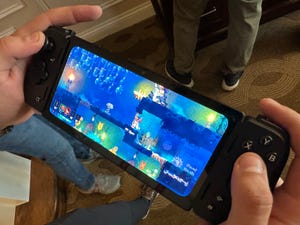
Razer Edge Game Handheld Is Here: Should You Buy One? - CNET
Nearly a decade ago, Razer’s convertible gaming tablet, the Razer Edge, was my favorite product from CES. The Razer Edge has been reborn, this time as a 6.8-inch tablet handheld console for $400 that also comes in an optional, Verizon-exclusive 5G-equipped version. And it’s now available for purchase.
We don’t have a full review yet. We’re waiting on our Edge to arrive. But we can help you decide whether it’s worth buying right now.
The new Edge, long teased by Razer in various forms since Qualcomm and Razer first showed off a handheld concept a year ago using a new gaming-centric G3X Gen 1 mobile processor, isn’t a wild new idea like the first Edge was to me. It’s the latest in a trend of game handhelds adopting ideas in the spirit of the Nintendo Switch, bringing handheld gaming back in new forms. It’s also, in a sense, like the Logitech G Cloud released last year: an Android handheld game device focused on local and cloud game streaming.
The Edge isn’t a Steam Deck-alike, even if it costs the same as one: This is an Android tablet, more like a large 6.8-inch phone that’s not a phone. It has a similar feel to smaller tablets of the past, like the Nvidia Shield Tablet, but far slimmer.
Hands-on thoughts: Yes, it’s like a phone with a controller
At first, it’s… underwhelming. I’ve seen Razer’s Kishi snap-on game controllers for phones, and the Edge has the same concept. It uses an improved version of the Kishi design with support for vibrating haptics, which I didn’t get to experience. The tablet part, well, it’s a tablet, like many Android things.
The combination of parts could add up to more, though. The large, vivid, 6.8-inch AMOLED display does look lovely, and the new G3X chipset on this tablet could be better at handling streaming games. Razer boasts that it’ll be the ultimate way to try Xbox cloud gaming or playing games via Steam Link, although I also didn’t try that yet either.

A closer look at the buttons and the top shoulder buttons/triggers.
James Martin/CNET
But the specs are nice: It has a 2,400×1,080-pixel resolution display that runs at up to 144Hz, and the G3X processor promises active cooling to prolong game sessions. The 128GB of storage can be bumped to 2TB with a microSD card slot. The Kishi V2 Pro controller it comes with, which is removable, adds vibrating haptics the other models didn’t have before. It uses Google Play plus existing streaming game services and Razer’s already-working Nexus app for captures and gameplay streaming. Its advantage, to me, is that it’s not starting over — it’s leaning on what already works, aiming to do it better.

The Edge detaches from its controller, and could just be used as a small Android tablet.
James Martin/CNET
The few games I did play were locally stored games such as Dead Cells, an older 2D platformer. The Edge is wide and a bit long, but compared to a Nintendo Switch or a Steam Deck, it wouldn’t seem out of place.

The Razer Edge feels compact enough, and its display looks great.
Scott Stein/CNET
Why not just buy a Kishi controller for your phone?
That’s the big question here. There are already several great snap-on controllers made for phones, and you could do the same and potentially get the same experience as the Edge. The Edge does have some added extras, including vibrating haptics in the controller and (maybe) boosted chip performance, but if you have a recent iPhone or Android phone, you might want to just convert what you have.
The Edge looks to propose a not-too-expensive solution, potentially, for those who don’t already have a phone… or who might want a dedicated device. That’s the idea, at least. How that ends up playing out versus a Steam Deck or a Nintendo Switch depends on whether you’d prefer to be in an Android ecosystem or not.
What about the 5G version?
We haven’t tested the Verizon-exclusive 5G model at all, but buying one with 5G obviously involves the cost of 5G service, and any other added costs via Verizon. Sure, that would mean the Edge would work anywhere with a decent Verizon cellular signal, but we don’t know how battery life on 5G will perform. If you really want an Edge, go with the regular Wi-Fi model and connect to a mobile hotspot.
Specs
The Razer Edge specs, in case you’re curious to compare against your phone, are:
- Qualcomm Snapdragon G3X Gen1 processor
- 2,400×1,080-pixel, 6.8-inch AMOLED display (144Hz)
- 8GB RAM
- 128GB internal storage (microSD card slot supports up to 2TB)
- Two microphones, two speakers
- Wi-Fi 6E
- Bluetooth 5.2
- USB-C port
- 3.5mm headphone jack
- eSIM for 5G model
- 260 x 85 x 11mm (10.2 x 3.3 x 0.4 inches)
- 264g (9.3 ounces) for tablet, 401g (14.1 ounces) for handheld and tablet together
You can wait it out
With something like the Edge, it all depends on how good it is at what it does. I can’t quite tell that yet. $400 is at least totally competitive with the cost of a Switch or Steam Deck. But would you want this over one of those? Or, would you just be happier using your phone and a similar controller? The Edge’s advantages seem intriguing, and I’m curious to play it more. But, with 2023 already looking to be a busy year for tech hardware releases, you also might want to wait to see what else is coming next.
Read more: The Must-See Tech of CES 2023: Sliding Foldables, Beastly OLED TVs and a Laptop-Charging Bike


